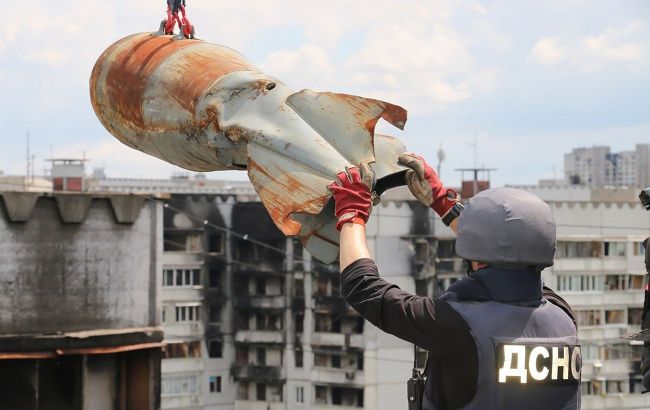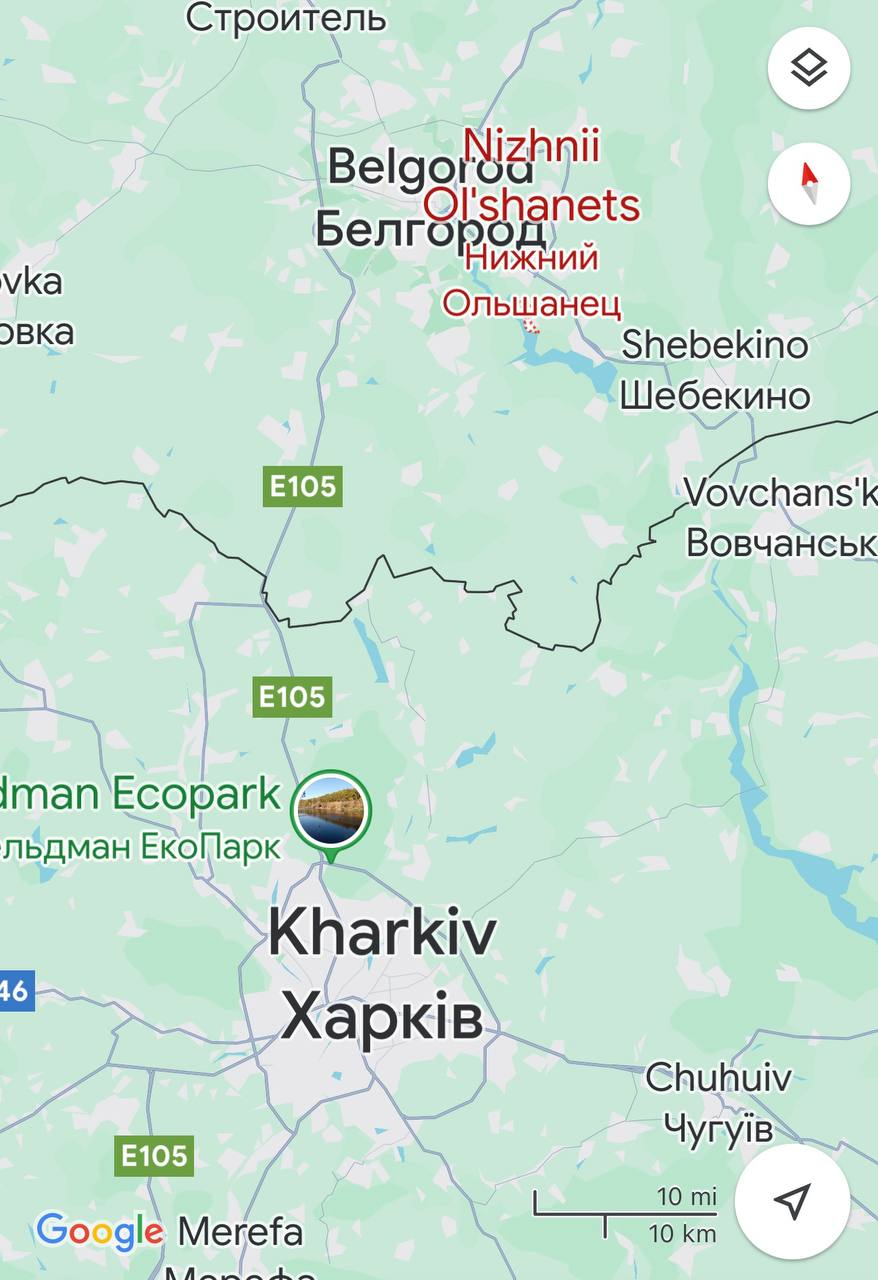Russia dropping rare aerial bombs on Kharkiv: What is known about FAB-500T
 Photo: State Emergency Service pyrotechnician retrieves an unexploded FAB-500 bomb (t.me/s_dsns_)
Photo: State Emergency Service pyrotechnician retrieves an unexploded FAB-500 bomb (t.me/s_dsns_)
Russian troops have begun targeting Kharkiv with precision-guided aerial bombs based on the FAB-500. According to debris evidence, a relatively rare version, the FAB-500T, was used, known for its thermoresistance and extended range compared to the standard version.
For more details on the FAB-500T and its differences from the standard version, check out the material by RBC-Ukraine.
Contents
- How Russia strikes Kharkiv with FAB-500 bombs
- What is known about the FAB-500T and how it differs from the standard FAB-500
- Why Russians began to use FAB-500T bombs to hit Kharkiv and how to deal with it
How Russia strikes Kharkiv with FAB-500 bombs
Last week, Russia bombed Kharkiv and the region multiple times with FAB-500 bombs equipped with a Universal Correction and Planning Module (UCPM).
UCPM is a set of equipment for converting free-falling aviation bombs into guided munitions (KAB). It consists structurally of folding wings, control systems, fuselage, mounting nodes, and other auxiliary elements. Control is likely done using satellite navigation and an inertial navigation system. The module increases the range and accuracy of deployment.
Initially, on June 26, FAB-500 bombs landed in the village of Borova, resulting in damage to shops and private houses. The following day, Russia struck the Kyivskyi district of Kharkiv, injuring five people and damaging three houses, university dormitories, and a State Emergency Service building.
One of the FAB-500 bombs pierced the wall of a private house but did not explode. At the time of impact, a 10-year-old boy was inside the house and remained unharmed. It's worth noting that on June 27, such an aviation bomb was used in Kharkiv for the first time.
"It is twice as powerful as the KAB and FAB-250 previously used to bomb Kharkiv daily," noted Oleksandr Filchakov, head of the regional prosecutor's office.

Photo: Judging from the fragments, on June 27, Russia struck with a FAB-500T bomb (khar.gp.gov.ua).
Towards the evening of June 30, the enemy attacked the city again. A FAB-500 bomb fell a few meters away from the Nova Poshta (New Post, a private Ukrainian postal and courier company) warehouse in Slobidskyi district. As a result, a fire broke out, eight vehicles were destroyed, one person was killed, and nine others were injured.
Of note, Russia used at least the rare FAB-500T in the initial strike. This is evidenced by photos published on the prosecutor's website.
According to the specialized portal Defense Express, prior to this incident, a bomb of the same type hit a private house in one of the villages in the Kharkiv region (also failed to detonate). The use of FAB-500T under UCPM modules in these episodes marks the first instances during the entire full-scale war of the Russian Federation against Ukraine.
What is known about the FAB-500T and how it differs from the standard FAB-500
FAB-500 is a 500-kilogram aviation bomb with a high-explosive warhead. The original model M-54 was produced in 1954 for heavy bombers, while the low-drag M-62 version in 1962 was designed for fighter-bombers.
According to open sources, the FAB-500 M-62 can be launched from altitudes of 570 to 12,000 meters, at speeds ranging from 500 to 1,900 km/h. It affects targets with the effects of explosion products, casing fragments, and shock wave. It was primarily used by Soviet forces in Afghanistan and later by Russian forces in Syria.
In 2023, correction and planning modules were installed on the FAB-500 M-62, increasing its range to 70 km. It was then that these bombs began to be used in the war against Ukraine.
The modules are called universal because any bomb can be mounted on them, notes aviation expert Valerii Romanenko.
"The bomb just attaches to the module like cargo, you can easily hook up any 'five hundred' (500 kg bomb, - ed.). The only thing that needs to be done according to the bomb type is to make changes to the program," he told RBC-Ukraine.
According to him, an aviation bomb can be volumetric-detonating, high-explosive, fragmentation-high-explosive, or cluster, which results in a weight difference of 10-20 kg. This necessitates changes to the bomb's flight program.
FAB-500T is one variant. The "T" index indicates thermal stability. It was developed for use with reconnaissance-strike aircraft like the MiG-25RB, which could reach speeds of up to 3000 km/h. Therefore, it must withstand corresponding temperature loads.
Due to its specific elongated aerodynamic shape, the FAB-500T can fly 30-40 km even without additional ballast, as noted by Defense Express.
Compared to the standard FAB-500 M62, the FAB-500T differs slightly with a lower explosive filler mass of 260 kg instead of 300 kg. It also has a different external appearance that provides better dynamic characteristics.
However, Romanenko doubts these assessments. According to him, there is no verified information on exactly how much explosive filler is inside, and perhaps the difference may not be significant at all.
"If the amount of explosive filler is less, it's in such a quantity that it doesn't affect anything at all," he emphasized.
A more telling fact is another. In at least two cases of dropping the FAB-500T, the detonator did not function.
"And this is critical for Russia. Due to the failure of the detonator, the bomb simply falls and only causes kinetic damage. Yes, there's still trouble, but the occupiers were counting on serious high-explosive effects," the expert added.
Why Russians began to use FAB-500T bombs to hit Kharkiv and how to deal with it
It should be noted that during the first strike on Kharkiv on June 27, FAB-500T bombs were launched from a Su-34 aircraft from the area of Mayak village in the Belgorod region. The distance from the launch site to the target was 65 km. The strike on the Nova Poshta warehouse was carried out from the area of Nizhnii Olshanets village in the Belgorod region. The distance from the launch site of the bomb was about 70 km.

Photo: Launch sites of FAB-500T bombs to Kharkiv from the Belgorod region (google.com.ua/maps)
Defense Express analysts believe that the integration of FAB-500T bombs onto the UMPK module is due to the need for longer-range bombs for strikes on Ukrainian territory. They argue this is not just about replacing the standard FAB-500 M62 with the same module.
According to Romanenko, this reasoning is only partially true. The FAB-500T already has better aerodynamics, providing it with a slightly greater range compared to the M62, although not significantly.
"The range is much greater compared to the old FAB-500 M-54, which has terrible aerodynamics. Compared to the M-62, the difference is only 3-5 km. If we were using the M-54, the difference would be much larger, possibly up to 10 km, although despite its poor aerodynamics, it is more accurate," he explained.
In March, the Russian Ministry of Defense revealed the production of FAB-500T bombs. Therefore, the focus is less on converting Soviet stocks into guided bombs and more on purposefully increasing the quantity of new aerial bombs. Until Ukraine finds a means of countering this, enemy strikes are likely to continue.
Romanenko explains that Russia's production potential for aerial bombs is virtually limitless.
"They would sooner give up bread, butter, and so forth, but not bombs. Expanding their quantity is an existential path for Russia. They will always manufacture bombs, so the means of countering them must be to neutralize the means of delivery overall," he noted.
Military and governmental authorities consider it nearly impossible to intercept corrected bombs. This perspective has been voiced during full-scale war as well. The sole method of defending Kharkiv and the front-line areas is to intercept the Su-34 bomber carriers.
The most apparent strategy is to bolster anti-aircraft defenses, including the introduction of F-16 fighter jets, with the first units expected by summer, though specific timelines remain unclear. Additionally, the deployment of long-range air defense systems aims to prevent Russian Su-34s from approaching launch boundaries.
Read more in the material by RBC-Ukraine Protecting Kharkiv: Ukraine's plan against Russian guided bombs before F-16 arrival.
Among the long-range air defense systems considered, Patriot systems are mentioned, capable of engaging aerodynamic targets at distances up to 150 km. However, President Volodymyr Zelenskyy recently acknowledged that this is not feasible due to the high cost of each interceptor missile, around $3 million, and Ukraine's lack of sufficient reserves for effective defense against aircraft.
Romanenko suggests the strategy should focus on destroying bomb carriers and targeting enemy airfields.
"This should target not the aircraft on the airfields, but the runways. This would force the Russians to repair them around the clock. This would significantly reduce the number of strikes. I don't see any other way. Russians are already making bombs weighing 3 tons with UMPK modules, and they will make 5-ton ones," he stated in an interview with RBC-Ukraine.
According to Forbes, the most critical target in this plan could be the Baltimore airfield near Voronezh, approximately 150 km from the Ukrainian border. Combat aircraft take off daily from there to drop precision-guided bombs. Su-34s reach the launch boundaries within minutes, and the large number of Sukhoi fighters based there allows continuous strikes along the entire front line.
It's likely that about half of the operational Su-34 fleet is based at Baltimore. The challenge remains that Ukraine currently lacks the means to effectively target it. The airfield is within range of ATACMS missiles, but the US administration has not yet authorized strikes of such depth.
Sources: information from open sources, data from the Kharkiv Regional Prosecutor's Office, statements from Prosecutor Oleksandr Filchakov, materials from Forbes and Defense Express, and comments from leading researcher of the National Aviation University of Ukraine, Valerii Romanenko.

